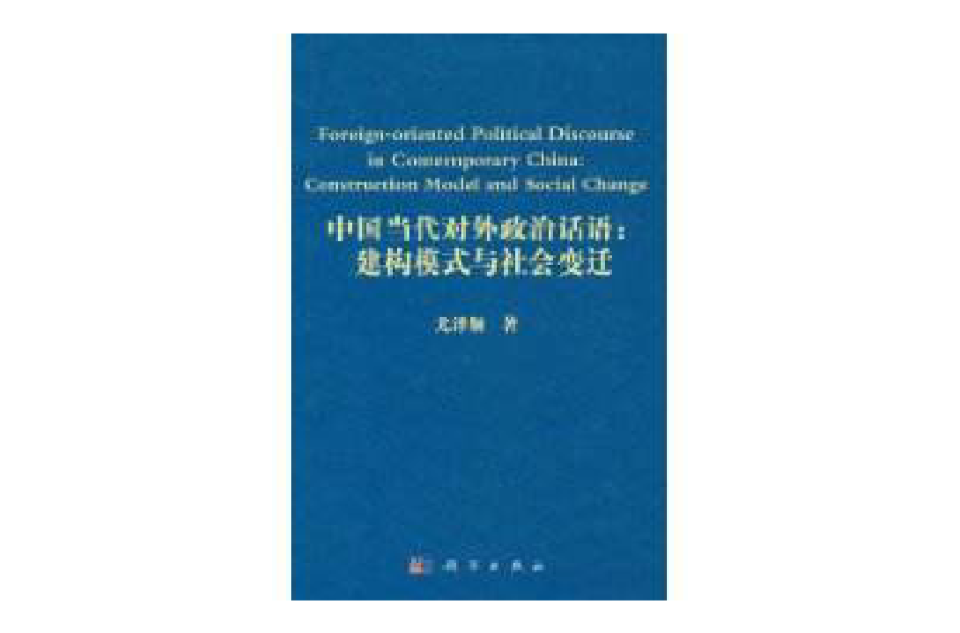《中國當代對外政治話語建構模式與社會變遷》是2010年12月1日科學出版社出版的圖書,作者是尤澤順。本書通過具體話語的分析,將源於西方的理論觀點和模式實際運用於我國獨特語境和中外政治話語互動語境內,在一定程度上為形成具有中國特色的話語分析和交流理論奠定基礎。
基本介紹
- 書名:中國當代對外政治話語:建構模式與社會變遷
- 作者:尤澤順
- ISBN:9787030297518
- 定價:48.00元
- 出版社:科學出版社
- 出版時間:2010年12月1日
- 開本:16開
內容簡介,圖書目錄,
內容簡介
《中國當代對外政治話語:建構模式與社會變遷》由尤澤順所著,並以《中國政府工作報告》、中國政要演講稿、《人民日報》(海外版)及其他官方報紙的相關評論和其他官方文本等構成的“中國當代對外政治話語”為研究對象,以批判性話語分析為主要研究視角,從語言層面揭示話語與社會變遷之間如何形成互動關係等。
圖書目錄
序言一
序言二
前言
Chapter 1 Political Discourse and Foreign-oriented Political Discourse
1.0 Introduction
1.1 From political rhetoric to political discourse analysis
1.2 Political discourse and foreign-oriented political discourse
1.3 Critical studies of political discourse
1.4 Key terms in political discourse analysis
1.4.1 Discourse
1.4.2 Critical
1.4.3 Ideology
1.5 Discourse as social cognitive, and historical process
1.5.1 Discourse as social process
1.5.2 Discourse as cognitive process
1.5.3 Discourse as historical process
1.6 Procedures and strategies of analysis
1.7 Organization of the book
Chapter 2 Discursive Construction of Chinese Foreign Policy
in the Annual Work Report to the NPC
2.0 Introduction
2.1 Critical studies of foreign policy discourse
2.2 The AWR and its FPS
2.3 Theoretical framework and analytical methods
2.3.1 CDA and foreign policy studies
2.3.2 Discourse practice as social practice and cognitive process
2.3.3 Procedures and strategies of analysis
2.3.4 Topical analysis, schematic analysis, and lexical analysis
2.4 Detailed analysis
2.4.1 An analysis of Year 1993 report
2.4.2 Diachronic analysis of the FPSs in the AWRs
2.5 Discussion
2.5.1 The construction of foreign policy in the AWR
2.5.2 The changes of discourse in the AWR
2.5.3 The interaction between policy discourse and social reality
2.5.4 China's foreign policy constructed discursively in the AWR
2.6 Summary
Chapter 3 Historical Discourse and the Ideological Construction
of China's "Peaceful Rise".
3.0 Introduction
3.1 Controversies over "peaceful rise".
3.2 "Peaceful rise" discourse as social cognitive, and historical
process
3.3 The image and construction model of "peaceful rise".
3.3.1 The image of "peaceful rise".
3.3.2 The construction model of "peaceful rise".
3.4 Discussion
3.5 Summary
Chapter 4 "Engagement" and the Construction of Solidarity
Between China and Others in the "Peaceful Rise"
Discourse
4.0 Introduction
4.1 Critical discourse studies of political speeches
4.2 China's "peaceful rise" and inter-state relations
4.3 Theoretical framework and analytical strategies
4.3.1 CDA and Engagement
4.3.2 Interpersonal relations and inter-state relations
4.3.3 Engagement as construction resources and as analytical strategies
4.4 Detailed analysis
4.4.1 General distribution of Engagement resources
4.4.2 Entertain
4.4.3 Acknowledge and distance
4.4.4 Deny and counter
4.4.5 Pronounce, endorse, and concur
4.4.6 Cooperative use of Heteroglossic Engagement
4.5 Discussion
4.6 Summary
Chapter 5 The Identity Construction of ASEAN and the China-
ASEAN Relations
5.0 Introduction
5.1 Language and identity in the international theory and in CDA
5.2 China-ASEAN relations and China's discursive construction of
ASEAN
5.3 Identity construction discourse as social cognitive, and
historical process
5.3.1 Identity construction discourse as social, cognitive, and
historical process
5.3.2 News headlines as analytical strategy
5.4 Detailed analysis
5.4.1 Different identities constructed for ASEAN
5.4.2 Diachronic changes of ASEAN's identities
5.5 Discussion
5.5.1 Society, history and identity construction
5.5.2 Cognition, identity construction, and China-ASEAN relations.
5.5.3 CDA and the constructivism and poststructuralism in IR
5.6 Summary
Chapter 6 "Harmony" and Chinese Spring Festival Celebration
Abroad
6.0 Introduction
6.1 Chinese spring festival celebration and its cultural implications
6.2 Theoretical framework for the analysis
6.3 Detailed analysis
6.3.1 Lexical reiteration
6.3.2 The selective use of pronoun welthey
6.3.3 Cultural symbol depicting
6.3.4 Social activity description
6.4 Discussion
6.5 Summary
Chapter 7 Tension Between the Educational Identity and the Marketized Discourse of "Confucius Institutes"
7.0 Introduction
7.1 Modernity and the expansion of the marketized discourse
7.2 "Confucius Institutes" and its identity construction
7.3 Theoretical framework and strategies for the analysis
7.3.1 Discourse, society and identity construction
7.3.2 Three-dimensional model of discourse analysis
7.3.3 Strategies of textual analysis
7.4 Detailed analysis
7.4.1 Marketized metaphors
7.4.2 Advertised language
7.4.3 Standardization of discourse
7.4.4 Professionalization of discourse
7.5 Discussion
7.5.1 The initial drive to construct a cultural educational identity for the institutes
7.5.2 The consequence of the marketization trend in the identity construction effort
7.5.3 The theoretical implications
7.6 Summary
Bibliography

